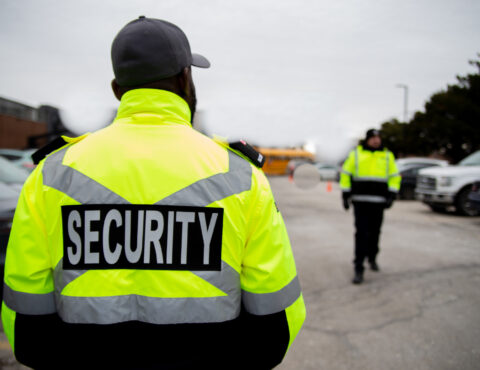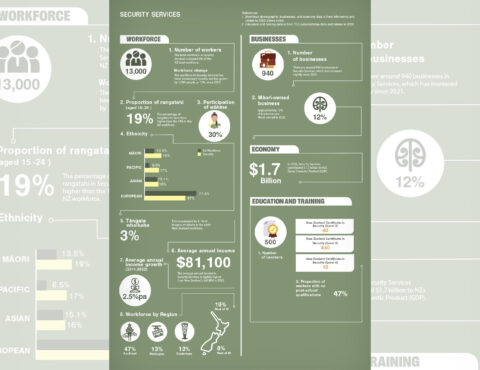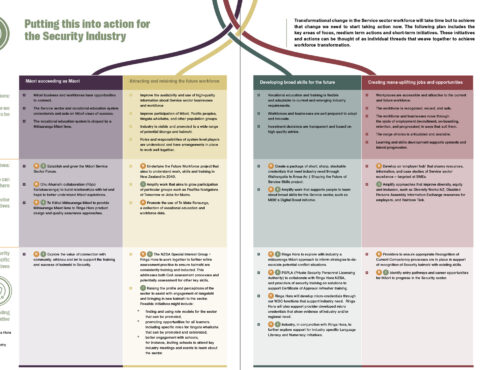Ringa Hora has worked with people from across industry to develop a shared roadmap to transform the Service sector workforce from its current state to the future that we aspire to.
The Workforce Development Plan looks across the Service sector and sets out the major factors shaping the sector and an overarching vision for the future.
Against that context, this Action Plan focuses on the characteristics and dynamics of the Security industry and its workforce. It describes what the future could look like for this workforce, the current challenges faced by the industry, and sets out the actions we can take to tackle this wero | challenge.
Ringa Hora’s Service Sector Workforce Development Plan is based on four aho | strands. Each of these aho will strengthen the workforce, but when woven together, as a taura whiri | rope, we can achieve real transformation of the workforce:
For the Security industry this looks like a future where the industry is empowered and can keep both the public of Aotearoa and their workforce safe. A successful Security industry can provide significant advantages regarding risk mitigation and safety for customers. This provides peace of mind and business continuity that may otherwise not be available.
We believe that the Security industry will thrive when the industry can meet the rising demand for their services. Kaimahi are seeking meaningful and fairly rewarded work that allow them to develop and progress. Through the numerous education and training channels, kaimahi can be upskilled and supported through their career journey, with skills that will see them through life wherever it takes them. Improving the literacy and numeracy of kaimahi is critical to this, as is the reduction of cost barriers of training, such as the Certificate of Approval (CoA) for security guards.

The Security industry keeps Aotearoa safe; the industry and its workforce prevents crime, promotes risk mitigation and improves confidence for customers and businesses. Security is often a requirement at large events that rely on an efficient and well-trained security workforce to deliver outstanding service and peace of mind.
There is growing demand for Security Services in light of rising crime and the security workforce has risen to this challenge to ensure the smooth operation of multiple events and day-to-day needs for everyday New Zealanders. The introduction of new technology solutions to assist with security for some customers has been changing the demands and operations of many businesses and roles within the Security industry.

To help us get to the future state, we need to understand and tackle the challenges that the Security Services sector faces, while also seizing the opportunities that already exist or are on the horizon. We’ve heard that the factors having a significant impact on the Security industry, including its approach to workforce development include labour and skills shortages, the rising cost of business, the need for qualifications and training to be fit for purpose, and some literacy and numeracy challenges.
Building on a strong foundation of career pathways to address labour and skills shortages
There is growth in demand for Security Services, however, the industry is struggling to meet this demand due to widespread labour shortages and retention issues. Static guards, event staff, and electronic security technicians are in particularly high demand. However, retention has been an issue for some time now. For example, of the 2,500 new workers in 2015, only a little over half remained for more than one year. That high exit rate eases after a year, indicating that is an important turning point for whether people stay in the industry or not. This shortage affects entry level to mid-level and management, with many kaimahi leaving the industry post-COVID-19.
Although labour and skill shortages are a challenge, this is an opportunity to focus efforts on improving the participation of currently under-represented groups across all areas and levels of the industry. For instance, there are very few tāngata whaikaha | disabled people in the industry even though many areas of Security would be suitable for this largely untapped workforce; for example, monitoring and communications is less likely to present environmental barriers for people with physical impairments.
Developing and credentialising fit for purpose skills and knowledge
The Security industry has a strong foundation for supporting people to enter, progress through, and exit the industry to allied industries. However, there is a need for better alignment between regulatory, industry, and vocational education requirements. It is important to ensure there is sufficient and fit-for-purpose training for kaimahi in the industry to promote career progression and improve its value for both learners and businesses. This can be done by:
Despite historically high engagement with vocational education, the industry has seen a decline in training enrolments over recent years. Industry have also identified a middle management gap and signalled that higher level qualifications may be needed to address this issue.
Recognising the costs of business and training
Beyond the initial entry point, there is a question of whether there should be a tiered or sequential approach to training and licensing supported by a mandatory CoA renewal process. This could help ensure emerging skill needs are met, while also confirming that existing skills and knowledge are current. For example, a major emerging skill need is in response to increased retail crime, with ram raids featuring prominently in recent media. The increased demands on the industry balanced with legislative limitations on how security staff can respond, has resulted in a push for more specialised training. Industry have also identified a middle management gap and signalled that higher level qualifications may be needed to address this issue.
Addressing the limited capacity to deliver training
There are a limited number of industry-endorsed trainers/providers offering the relevant skills (such as conflict de-escalation which is in significant demand) and this distribution in unevenly spread throughout the country. This pressure is exacerbated by the need for training tailored to different locations and contexts and a strong industry expectation for training to be delivered face-to-face. There is an appetite for remote or blended options in greater demand in rural or remote areas. Industry has been working closely with Ringa Hora in 2023 to support improved consistency of assessment practice.
Addressing literacy and numeracy barriers
Although some people may have the industry interest and competence that means they are well suited to having their skills and knowledge recognised through higher level credentials and associated work opportunities, they may have literacy or numeracy issues. In these situations, targeted support even if it’s
not industry-specific, may open the gateway for parts of the existing workforce to grow their Security
career further.
The Security sector is a significant employer and has grown significantly over the last decade, increasing 50% from 10,000 employees in 2015 to 13,000 kaimahi in 2022.
Security is an accessible entry point for people who do not necessarily have previous work experience or qualifications. The industry can also provide a wide variety of career pathways to be explored within the sector, including data management, security consultants, electronic technicians, patrol officers and dedicated officers for event security and other contexts.
Embracing and celebrating diversity makes businesses more attractive to potential kaimahi and customers, as well as creating economic and social benefits for employers, the workforce, and the wider community.
Using workforce participation data as a starting point shows that there are some strengths and also some more work be done in the Security industry to realise the aspirations and potential of Māori, Pacific peoples, and tāngata whaikaha | disabled people:
![]()
There is a high proportion of Māori within the industry. The industry is seen as ‘accessible’, however, it can be hard to progress within the sector due to cost and education barriers which prevent many kaimahi from being able to gain licenses. In addition, there are limited credentials recognised outside of the industry so this can also make it difficult for many to progress in their career journey in other fields also.
![]()
The Security industry has a high proportion of Pacific peoples. Therefore, it is important that a tailored training is offered to Pacific workers, along with pastoral care; both have been identified as critical to supporting and retaining kaimahi of Pacific descent.
![]()
Tāngata whaikaha includes physical, mental, intellectual, or sensory impairments which can impact a person’s life to varying degrees and in different ways. We acknowledge that data on tāngata whaikaha is limited and it is important that we create more growth opportunities within the sector for our tāngata whaikaha workforce.

Explore the Security industry workforce demographic, business, and economy statistics, and education and training data.

Transformational change in the Service sector workforce will take time but to achieve that change we need to start taking action now. The Security action plan includes the key areas of focus, medium-term actions and short-term initiatives. These initiatives and actions can be thought of as individual threads that weave together to achieve workforce transformation.